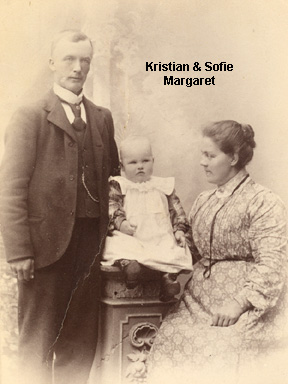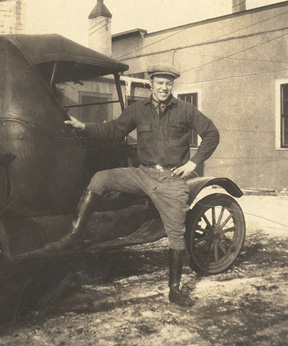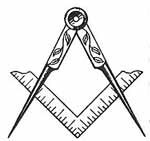 Erling Eide1905 - 1990
Born: 9/21/1905 - Vestre Toten, Norway
By John Kelly, Son of Betty Kelly,
Erling Eide imagined what it would be like to be a sea captain, with Gilbert as his first mate, sailing the oceans and discovering exotic places like Isle Royal. His family had sailed across the Atlantic Ocean to get here. He tried to imagine what it was like when his parents, Sofie and Kristian, with his sister Margaret and himself, not yet one year old, sailed from Oslo, Norway across the Atlantic Ocean to New Brunswick, Canada (?) in February of 1906.
Gilbert Bloomquist, Erling’s boyhood friend, would later marry Erling’s cousin, Alma Andersen. Alma was the daughter of John Andersen and Alea Furseth. John was Sofie’s brother. He chose to use the name Andersen rather than Guttormsen. His father was Anders Guttormsen. Family records sometimes list Sofie’s last name as Andersen as well as Guttormsen. This is a little confusing since Sofie was a daughter not a son.
How did the Edie family get from the east coast of Canada to far end of Lake Superior in Minnesota? How did a poor family with little money cross the barren lands of Canada to reach Grand Marais, Minnesota, on the western edge of Lake Superior, just twenty miles from the Canadian Boarder? Did they come by water down the St. Lawrence Seaway via the Great Lakes? Did they take a train? Why did they come here? Why not any of the thousands of places in-between? Did Sofie’s brother John live there first and encourage her to come to Minnesota and homestead some of the free land that was available?
Birth
Further searching on the internet uncovered an entry from a police log documenting arrivals and departures from Vestre Toten. Astonishingly there was an entry for Kristian Eide, Erling’s father. Kristian and Sofie arrived in Vestre Toten March 15, 1903 when Kristian was 26 years old. Sofie was pregnant and their first child, Magnhild, who was born August 19, 1903, five months after their arival. Magnhild is feminine Norwegian name derived from old Norse “magn” meaning “mighty, strong" and “hildr” meaning "battle". It was also the name of a novel by the Norwegian author Bjørnstjerne Bjørnson, published in Norwegian in 1877 and in English in 1882. Later, when they immigrated to the United States, the name Magnhild was changed to Margaret and she was called Maggie.
The police log for Vestre Toten gives Sofie’s maiden name as Andersen, but her name on the baptismal certificate is Guttormsen. I do know from family interviews I did in 1972 that her father was Anders Guttormsen. Sofie’s mother’s maiden name was Marit. I had also made notes in 1972 that Sofie’s sister Mary had been born in Foldalen, Norway, which agrees with the police log as the place where Kristian and Sofie were born.
In my notes from 1972, I recorded that Erling’s next younger sister, Amelia, was born on 9/22/07 in Cameron, WI, so it would seem that they came to the United States directly, not via Canada, as some people have suggested. If they did go to Canada first, why did they end up in the interior of Wisconsin? The fourth child, Richard, was born in Grand Marais, MN ,11/24/09. So we know that some time between 1907 and 1909, the Eide’s made their way to Grand Marais with at least one stop after landing in America.
Homesteading
The Homestead Act of 1862 revolutionized the rural landscape in America by stimulating the development of over 372,000 farms. It was one of those ideas that worked beyond everyone’s wildest imagination. Too many government programs suffer from negative unintended consequences, but is an idea that worked, and Kristian and Sofie Eide participated in the great experiment. The Homestead Act was passed in 1862, after 70 years of haggling in congress. The southern states had blocked the concept of giving away government land to create farms. They were afraid of its impact on slavery. But when the southern states succeeded from the union and withdrew from congress in 1861, the opposition was gone, and the act was passed in 1862.
By 1906, when the Eide’s came to America, the best homestead land was already taken, but there was still land available in rural areas like Cook County in Northern Minnesota. And though the land was cold and rugged, just like their homeland, it was filled with thousands of other Scandinavians. The combination of free land, fellow countrymen, and a familiar landscape, made for an irresistible opportunity to an adventuresome young family with little opportunity at home.
The Eide’s laid claim to 160 acres officially designated as the south-west quadrant in Section 29 of Township 62N and Range 3E in Cook County, Minnesota. The rectangular survey system, now known as the Public Land Survey System (PLSS) was established by the Land Ordinance Act of 1785. It was this system that was used to identify and subsequently sell all government land via the Homestead Act. The largest named unit of land was called a Township, not to be confused with the political or city designation of a township. Each township consists of a square shape divided into 36 sections with six sections on a side. A section is one square mile or 640 acres. The 36 sections in a township are numbered in a switchback fashion as illustrated here. Since a section is one mile square, a township is six miles square. A section is further divided into four quadrants of 160 acres. The four quadrants are denoted NW, NE, SW, and SE. The quadrant became the basic unit of land to be given away by the Homestead Act. School
A historical photo was published in the Cook County News-Harold of Grand Marais in 1996 showing the entire student body of the East Colvill (sp?) School consisting of eleven children , four of whom where Eides: Erling, Maggie, Amelia, and Dick. Dick (Richard) appears to be eight or nine years old so the photo must have been taken around 1917 or 1918. Erling would have been twelve or thirteen. This was a classic one room school house with the Eide’s making up nearly half of the students. In spite of his limited education, Erling went on to become a successful real-estate appraiser and an associate member of Society of Residential Appraisers. To his credit, Erling was the only member of the Society of Residential Appraisers that did not have a college degree. He clearly had a knack for numbers, as his grandson, Tom Kelly, tells stories of Grandpa Eide being able to multiple three digit numbers in his head. Family FireMany years later, in the 1970’s, when Erling was a grand parent himself, he nearly died in another fire when he fell asleep smoking a cigarette. He was living on Orchard Avenue; Mildred his wife was in the hospital. A passing motorist, seeing smoke coming from windows and doors, stopped and called the fire department. The identity of that Good Samaritan was never identified. Striking Out on His Own
Erling took his first train ride in 1914 on the Mesaba Railway Company intercity electric trolley, which ran between Gilbert and Hibbing from 1912 to 1927. The Globe Hotel in Eveleth, a site on the National Registrar of Historic Places, was an important stop on the trolley. The trolley served as a commuter train to thousands of passengers daily, reaching as many as ten towns in the area. Shortly after its start, the rail line started receiving competition in 1914 from what would become the first intercity bus line in the country, Greyhound Bus Lines. Besides iron ore, Hibbing is also famous as the birth place of Bob Dylan. Of course, that didn’t happen until 5/24/41.
In July of his sixteenth year, 1922, Erling decided to strike out on his own and headed for Duluth Minnesota. This was no small adventure. Duluth was a big, dangerous city. Located at the western most tip of Lake Superior, Duluth was a major seaport. In the early 1900’s, due to lumber and iron ore, it shipped more tonnage than New York City. Duluth was not the kind of place a mother would want to send her sixteen year old son. Besides a reputation for hard drinking seamen, Duluth had become famous throughout the country for the “Duluth Lynchings” which had taken place June 14, 1920. A circus, The James Robinson Circus, had come to town. Six Negro circus workers were accused or raping a teenage white girl. The workers were arrested and put in jail, but a mob of a thousand or more people stormed the jail and pulled three of the men out and hanged them from a street lamp. It was an appalling example of racial hatred. A photo of the event was turned into a postcard. There never was any evidence that a rape took place. The Minnesota Historical Society web site has an excellent audio-visual presentation on the event.
Military Service
Marriage
The story of how Erling and Mildred met is part of family folklore. He was a wonderful story teller and could mesmerize his children and grandchildren with stories of crossing the country in covered wagons, clearing land in Northern Minnesota, and other fanciful adventures. As he liked to tell it, he met Mildred at the Minnesota State Fair. He was there with two friends waiting in line to ride the ferris wheel. Since the chairs only held two persons, he was forced to ride with the next person in line, who just happened to be Mildred. It is lovely story, but it may be just that, a story. Would Mildred really have been at the State Fair as the mother of an infant? It’s certainly possible, but it just as possible that he fabricated this story to match the story of his wedding which supposedly happened in 1923.
Career
Coming back to Minneapolis, he obtained employment with Gamble Skogmo as a truck driver. While there, he traveled to Detroit Michigan to bring back the companies first semi-truck. He worked at Gambles from the mid 30's until 1942 (Click for Photo).
In 1942 he started work with a real estate agent for his cousin Anton Hanson at Hanson Realty on Lake and Bloomington. Anton was the son of Mary Guttormsen, his mother’s older sister, and Hans Kveberg. Notice that Anton took the name Hanson. Other children took the name Kveberg, making it difficult to track family members. It seems many of the Guttormsen/Andersen's found their way to Minnesota.
In 1948 he went to First Federal Savings and Loan as a mortgage appraiser for 1 ½ years. He then moved to Twin City Federal in 1950 and retired from there in 1970. The photo at the top of this article is from his retirement. The Twin City Federal story has been well told by Doniver Adolph Lund in the book, Billions for homes: The TCF story Norwegian HeritageReligious Beliefs
Masonic Membership
The Masons profess to be non-religious, but there are strong religious overtones to the organization. Basic membership requires a believe (faith) in God or some supreme being. Membership in the York Rite requires a Christian belief. A formal statement on religion is reproduced on this web site.
Three good online sources of information on Masonry can be found at:
Minnesota Lake HomeResidences
Additional Documents and Photos |
 While searching the internet, I found a site “
While searching the internet, I found a site “

